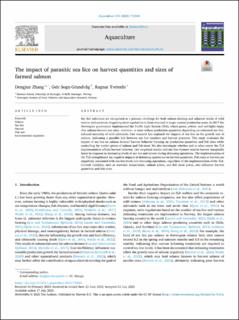| dc.contributor.author | Zhang, Dengjun | |
| dc.contributor.author | Sogn-Grundvåg, Geir | |
| dc.contributor.author | Tveterås, Ragnar | |
| dc.date.accessioned | 2023-08-23T08:29:35Z | |
| dc.date.available | 2023-08-23T08:29:35Z | |
| dc.date.created | 2023-08-22T14:18:49Z | |
| dc.date.issued | 2023-07 | |
| dc.identifier.citation | Zhang, D., Song-Grundvåg, G., Tveterås, R. (2023) The impact of parasitic sea lice on harvest quantities and sizes of farmed salmon. Aquaculture, 576, 739884 | en_US |
| dc.identifier.issn | 0044-8486 | |
| dc.identifier.uri | https://hdl.handle.net/11250/3085367 | |
| dc.description.abstract | Sea lice infections are recognized as a primary challenge for both salmon farming and adjacent stocks of wild salmon and sea trout, triggering strict regulations at farm sites and in larger coastal production areas. In 2017 the Norwegian government implemented the Traffic Light System (TLS), where green, yellow, and red lights imply that salmon farmers can raise, maintain, or must reduce production quantities depending on estimated sea lice-induced mortality of wild salmonids. Past research has explored the impacts of sea lice on the growth rate of salmon, indicating a possible link between sea lice numbers and harvest practices. This study evaluates the impact of sea lice on salmon farmers' harvest behavior focusing on production quantities and fish sizes while controlling for market prices of salmon and fish meal. We also investigate whether and to what extent the TLS implementation affects harvest behavior. Our empirical results indicate that farmers tend to harvest marginally faster in response to increasing levels of sea lice and slower during delousing operations. The implementation of the TLS strengthened the negative impacts of delousing operations on harvest quantities. Fish sizes at harvest are negatively associated with sea lice levels and delousing operations, regardless of the implementation of the TLS. Control variables, such as seawater temperature, salmon prices, and fish meal prices, also influence harvest quantities and fish sizes. | en_US |
| dc.language.iso | eng | en_US |
| dc.publisher | Elsevier Ltd. | en_US |
| dc.rights | Navngivelse 4.0 Internasjonal | * |
| dc.rights.uri | http://creativecommons.org/licenses/by/4.0/deed.no | * |
| dc.subject | økonomi | en_US |
| dc.subject | akvakultur | en_US |
| dc.subject | fiskerinæringen | en_US |
| dc.subject | fiskeoppdrett | en_US |
| dc.subject | laks | en_US |
| dc.subject | lakseoppdrett | en_US |
| dc.subject | lakselus | en_US |
| dc.title | The impact of parasitic sea lice on harvest quantities and sizes of farmed salmon | en_US |
| dc.type | Peer reviewed | en_US |
| dc.type | Journal article | en_US |
| dc.description.version | publishedVersion | en_US |
| dc.rights.holder | © 2023 The Author(s). | en_US |
| dc.subject.nsi | VDP::Landbruks- og Fiskerifag: 900::Fiskerifag: 920 | en_US |
| dc.subject.nsi | VDP::Samfunnsvitenskap: 200::Økonomi: 210 | en_US |
| dc.source.volume | 576 | en_US |
| dc.source.journal | Aquaculture | en_US |
| dc.identifier.doi | 10.1016/j.aquaculture.2023.739884 | |
| dc.identifier.cristin | 2168789 | |
| dc.source.articlenumber | 739884 | en_US |
| cristin.ispublished | true | |
| cristin.fulltext | original | |
| cristin.qualitycode | 2 | |

